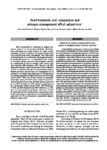Please use this identifier to cite or link to this item:
http://www.alice.cnptia.embrapa.br/alice/handle/doc/1043342Full metadata record
| DC Field | Value | Language |
|---|---|---|
| dc.contributor.author | PINHEIRO, V. | pt_BR |
| dc.contributor.author | NASCENTE, A. S. | pt_BR |
| dc.contributor.author | STONE, L. F. | pt_BR |
| dc.contributor.author | LACERDA, M. C. | pt_BR |
| dc.date.accessioned | 2016-04-14T11:11:11Z | pt_BR |
| dc.date.available | 2016-04-14T11:11:11Z | pt_BR |
| dc.date.created | 2016-04-14 | pt_BR |
| dc.date.issued | 2016 | pt_BR |
| dc.identifier.citation | Pesquisa Agropecuária Tropical, Goiânia, v. 46, n. 1, p. 72-79, jan./mar. 2016. | pt_BR |
| dc.identifier.issn | 1983-4063 | pt_BR |
| dc.identifier.uri | http://www.alice.cnptia.embrapa.br/alice/handle/doc/1043342 | pt_BR |
| dc.description | Water availability for cultivation of irrigated rice (Oryza sativa L.) is decreasing worldwide. Therefore, new technologies are needed to grow rice under aerobic conditions, in order to produce rice grains without yield losses and with lower water consumption. This study aimed at determining the best combination of management options for producing upland rice. A randomized blocks design, in a factorial scheme, was used. The treatments consisted of a combination of five rice cultivars (BRS Caçula, BRS Serra Dourada, BRS Primavera, BRS Sertaneja and BRS Esmeralda) with two compaction pressures in the seed furrow (25 kPa or 126 kPa), two types of seed treatment (with or without pesticide) and two types of N management (all at sowing or all at topdressing). Applying N at sowing instead of at topdressing produced higher grain yield in the no-tillage system (NTS). Under this system, upland rice genotypes show higher grain yield with higher compaction pressure. Seed treatment with pesticide provided greater grain yield for the BRS Sertaneja, in NTS, and for all genotypes in the conventional tillage system (CTS). BRS Esmeralda, in NTS, and BRS Esmeralda and BRS Primavera, in CTS, were the most productive genotypes. Moreover, in NTS, the application of N at sowing and the compaction pressure on the seed furrow are important for increasing upland rice grain yield. In CTS, seed treatment is important to improve upland rice grain yield. | pt_BR |
| dc.language.iso | eng | eng |
| dc.rights | openAccess | eng |
| dc.subject | Arroz aeróbico | pt_BR |
| dc.title | Seed treatment, soil compaction and nitrogen management affect upland rice. | pt_BR |
| dc.type | Artigo de periódico | pt_BR |
| dc.date.updated | 2017-03-03T11:11:11Z | pt_BR |
| dc.subject.thesagro | Arroz | pt_BR |
| dc.subject.thesagro | Oryza sativa | pt_BR |
| dc.subject.thesagro | Cupim | pt_BR |
| dc.subject.thesagro | Pesticida | pt_BR |
| dc.subject.thesagro | Nitrogênio | pt_BR |
| dc.subject.thesagro | Tratamento de semente | pt_BR |
| dc.subject.thesagro | Compactação do solo | pt_BR |
| dc.subject.nalthesaurus | fipronil | pt_BR |
| riaa.ainfo.id | 1043342 | pt_BR |
| riaa.ainfo.lastupdate | 2017-03-03 | pt_BR |
| dc.contributor.institution | VENERALDO PINHEIRO, CNPAF; ADRIANO STEPHAN NASCENTE, CNPAF; LUIS FERNANDO STONE, CNPAF; MABIO CHRISLEY LACERDA, CNPAF. | pt_BR |
| Appears in Collections: | Artigo em periódico indexado (CNPAF)  | |
Files in This Item:
| File | Description | Size | Format | |
|---|---|---|---|---|
| CNPAF2016pat.pdf | 267,77 kB | Adobe PDF |  View/Open |









